复习动词ing形式的用法
- 格式:pptx
- 大小:162.78 KB
- 文档页数:21
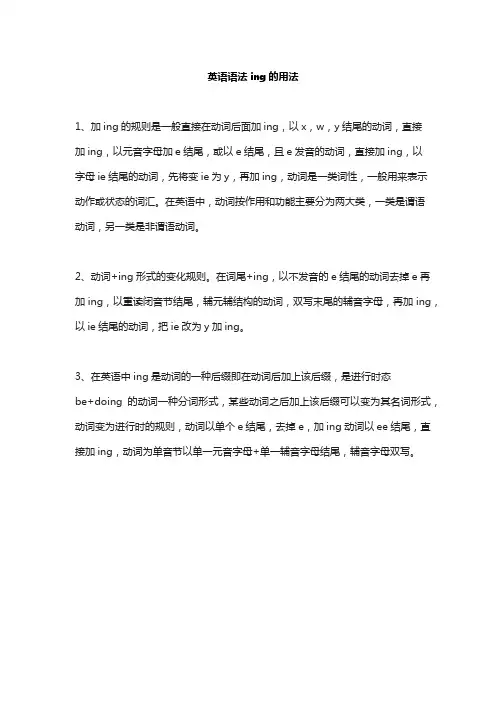
英语语法ing的用法
1、加ing的规则是一般直接在动词后面加ing,以x,w,y结尾的动词,直接
加ing,以元音字母加e结尾,或以e结尾,且e发音的动词,直接加ing,以
字母ie结尾的动词,先将变ie为y,再加ing,动词是一类词性,一般用来表示动作或状态的词汇。
在英语中,动词按作用和功能主要分为两大类,一类是谓语
动词,另一类是非谓语动词。
2、动词+ing形式的变化规则。
在词尾+ing,以不发音的e结尾的动词去掉e再加ing,以重读闭音节结尾,辅元辅结构的动词,双写末尾的辅音字母,再加ing,以ie结尾的动词,把ie改为y加ing。
3、在英语中ing是动词的一种后缀即在动词后加上该后缀,是进行时态
be+doing的动词一种分词形式,某些动词之后加上该后缀可以变为其名词形式,动词变为进行时的规则,动词以单个e结尾,去掉e,加ing动词以ee结尾,直接加ing,动词为单音节以单一元音字母+单一辅音字母结尾,辅音字母双写。
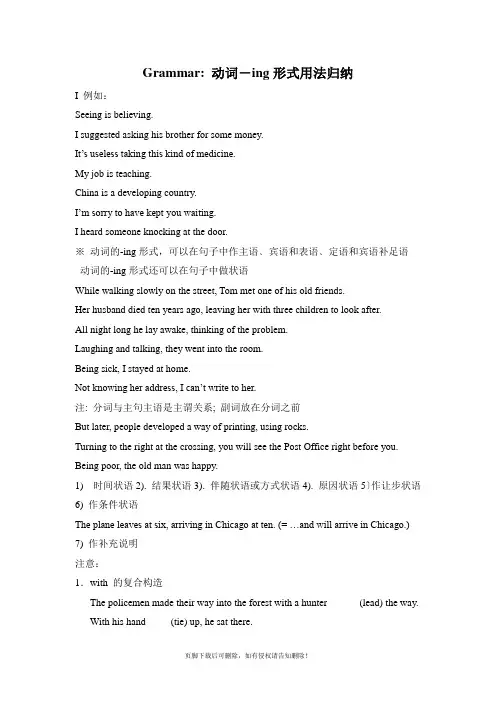
Grammar: 动词-ing形式用法归纳I 例如:Seeing is believing.I suggested asking his brother for some money.It’s useless taking this kind of medicine.My job is teaching.China is a developing country.I’m sorry to have kept you waiting.I heard someone knocking at the door.※动词的-ing形式,可以在句子中作主语﹑宾语和表语﹑定语和宾语补足语动词的-ing形式还可以在句子中做状语While walking slowly on the street, Tom met one of his old friends.Her husband died ten years ago, leaving her with three children to look after.All night long he lay awake, thinking of the problem.Laughing and talking, they went into the room.Being sick, I stayed at home.Not knowing her address, I can’t write to her.注: 分词与主句主语是主谓关系; 副词放在分词之前But later, people developed a way of printing, using rocks.Turning to the right at the crossing, you will see the Post Office right before you. Being poor, the old man was happy.1) 时间状语2). 结果状语3). 伴随状语或方式状语4). 原因状语5〕作让步状语6) 作条件状语The plane leaves at six, arriving in Chicago at ten. (= …and will arrive in Chicago.) 7) 作补充说明注意:1.with 的复合构造The policemen made their way into the forest with a hunter______ (lead) the way.With his hand ____ (tie) up, he sat there.With his eyes_____ (fix) on the wall, Tom lay on the floor.With a lot of homework___ (do), Jim can’t go out with his friends.2. 独立主格构造If weather permits, we will go out for a picnic tomorrow.=Weather permitting, we will go out for a picnic tomorrow.There is nobody in the room. Come in and have a chat.=There being nobody in the room, come in…Eg. The baby fell from the tree, blood ____ (come) down from his leg.3. 为了强调与谓语动词同时发生,在动词的-ing 之前可用when或while;为强调在谓语动词之前或之后发生,在动词的-ing 之前可用before或after.Eg. Don’t laugh, while eating.Before going abroad, he studied in Peking University.After watching TV, he went to bed.4. 在动词的-ing 之前可用on或upon, 表示〞一….就…〞.Eg. On/Upon arriving in Bejing, he went to see his uncle.5.为了强调结果, 可在动词的-ing 之前用thus.Eg. My friend Lucy works hard, thus getting praised by her boss.6. 在动词的-ing 之前可用though或although,Eg. Though working hard, he couldn’t make enough money to pay off his debts.II.-ing各种变化形式(doing/being done/having done/ having been done)1) 动词-ing形式的一般式表示动作与谓语动词同时发生﹑几乎同时发生或在谓语动词前发生。
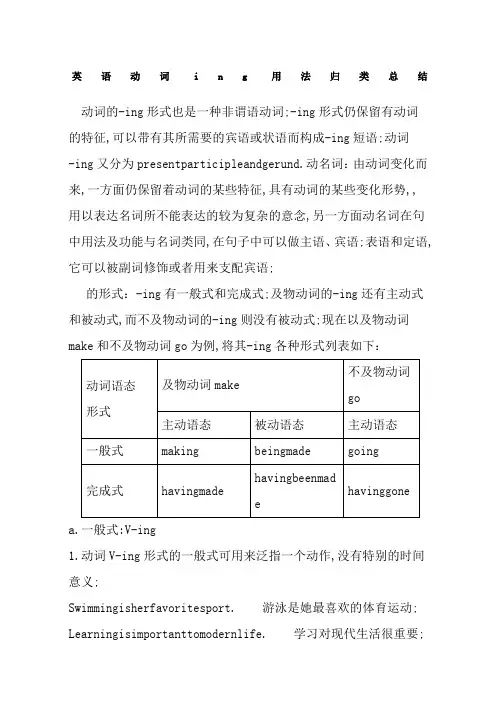
英语动词i n g用法归类总结动词的-ing形式也是一种非谓语动词;-ing形式仍保留有动词的特征,可以带有其所需要的宾语或状语而构成-ing短语;动词-ing又分为presentparticipleandgerund.动名词:由动词变化而来,一方面仍保留着动词的某些特征,具有动词的某些变化形势,,用以表达名词所不能表达的较为复杂的意念,另一方面动名词在句中用法及功能与名词类同,在句子中可以做主语、宾语;表语和定语,它可以被副词修饰或者用来支配宾语;的形式:-ing有一般式和完成式;及物动词的-ing还有主动式和被动式,而不及物动词的-ing则没有被动式;现在以及物动词make和不及物动词go为例,将其-ing各种形式列表如下:a.一般式:V-ing1.动词V-ing形式的一般式可用来泛指一个动作,没有特别的时间意义;Swimmingisherfavoritesport. 游泳是她最喜欢的体育运动; Learningisimportanttomodernlife. 学习对现代生活很重要;2.动词V-ing形式的一般式可用来表示与谓语动词同时发生的动作;Theywentoutoftheclassroom,talkingandlaughing.他们有说有笑地走出教室;3.动词V-ing形式的一般式有时也可表示在谓语动词的动作之前或之后发生的动作;Irememberedsendinghimane-maillastweek.我记得上星期给他发过一份电子邮件; HesuggestedtakingmydaughtertothezoothenextSunday.他建议下个星期天带我女儿去动物园;b.完成式:havingdone1.动词V-ing形式的完成式表示一个已完成的动作,这个动作发生或完成在谓语动词表示的动作之前;一般在句中作时间或原因状语用;句中的主语是它的逻辑主语,并且是它所表示的动作的执行者,如:Havingansweredtheletter,shewentontoreadanEnglishnovel. Havinglivedinthiscityforthreeyears,sheknowsitverywell. Nothavingstudiedhislessonsveryhard,hefailedtheexamination s.因为没有努力学习功课,他考试不及格;注意:在现代英语中,作宾语的动词V-ing形式的完成式可用一般式来代替;Ireallyregrettedmissingsuchanexcitinglecture.错过了这么振奋人心的演讲,我真的很遗憾;=Irallyregrettedhavingmissedsuchanexcitinglecture. Werememberedseeingthefilm.我们记得看过这部电影;=Werememberedhavingseenthefilm.的被动形式beingdone,表示它的逻辑主语是动词-ing形式表示的动作的承受者;被动语态-ing一般式所表示的动作是一个正在进行中的被动动作,而且这个被动动作也是和句中谓语所表示的动作同时发生的;它一般在句中作定语或状语用;-ing完成被动式所表示的动作发生在谓语动词所表示的动作之前,在句中一般作状语用;如:Thetruckbeingrepairedthereisours. Thequestionbeingdiscussedisveryimportant.正在讨论的问题很重要;Ican’tstandbeingkeptwaiting.我不堪久等; Thequestionbeingdiscussedisveryimportant.正在被讨论的问题很重要;Havingbeenshownthelab,weweretakentoseethelibrary. Havingbeencriticizedbytheteacher,hegaveupsmoking.被老师批评以后,他把烟戒了;注意:在need,want,require,beworth等动词短语后,作宾语的-ing常用主动形式来表示被动含义;如:Yourshoesneedcleaning.=Yourshoesneedtobecleaned.你的鞋需要清洗一下了;Thisbookiswellworthreading.这本书很值得一看;的被动形式havingbeendone表示动作在谓语表示的动作之前发生;Havingbeenshownthelab,weweretakentoseetheschoollibrary.在被带去看了实验室之后,我们又被带去参观校图书馆;否定形式:not+V-ing Hisnotcomingmadeeveryonepresentverydisappointed.他没来使在场的每个人都很失望;形式的基本用法;1作主语:动名词作主语与不定式作主语在语序位置方面较相似,但在表达意思上有差异;动名词作主语时,它已经将动作名词化了,已把某个动作视为某种活动或是某件事情了,动作意义很弱,比较抽象;而不定式作主语的动作意义较强,多指"要是去做某事",这种动作往往是"要发生的一次性动作",比较具体;例如:Breathingbecamedifficultatthataltitude.在那个海拔高度呼吸变得很困难; ReadingEnglishaloudinthemorningwilldoyoualotofgood.早晨朗读英文会给你带来许多好处; Cheatingonanexamruinsone'scharacter.考试作弊毁坏人的性格;Ittakesmetenminutestogethomefrommyoffice.我从办公室回家要花十分钟;Itneedstimetomakethreecopiesofit.把它复制三份需要时间;–ing形式作主语时,如果其结构较长,可用it作形式主语,而将作主语的-ing后置;如:Itisn’tmuchgoodwritingtothemagain.It’snousewaitinghere.动名词作主语时,也常用"Itis…"和"Thereis…"两种句型; "Itis…"的句型常用于说明"某种活动或是某件事情是如何,如何";强调事物的性质、特征等;常用于Itis后面的词有:nogood,nouse,useless,awaste,worthwhile,dangerous等等;句型"Thereis…"往往用于说明"不允许、禁止某种活动或是某件事情发生或存在";类似一种建议、命令等;例如:Itisnousewaitingforhimanylonger.等他是没有用的; Itisnogoodlearningwithoutpractice.学而不实践是没好处的; Itisdangeroususingthismethodtomeasurethespeedoflight.用这种方法去测量光速是危险的; Itisworthwhileconsultingyourtutoraboutitagain.很值得再向你的指导老师咨询一下这个问题; Thereisnojokingaboutsuchmatters.这种事开不得玩笑; ThereisnodenyingthefactthatChinahasmadearapidprogressinev eryaspectsinceitwasfounded.不能否认这个事实,中国自它成立以来已在各个方面都取得了飞速的发展;Thereisnolitteringabout.不许乱扔杂物;注意以下几种结构:1.There’snotellingwhatwillhappen.=It’simpossibletotellwhatwillhappen.=Noonecantellwhatwillhappen.2.It’snousetalkingwithhim.It’snogoodspeakingtothemlikethat.3.There’ssomedifficultyindoing…在此句型中,difficulty可以由以下单词替换:trouble,problem,fun,pleasure,agoodtime,ahardtime2作表语:动词-ing作表语表示主语所处的状态;动名词作表语主要说明"主语是做什么的、或是怎么回事",动作意义弱,较抽象;而现在分词作表语则主要是表示"主语的性质、特征等";不定式作表语却主要说明或解释"主语要去做什么事",它比动名词更为具体,动作意义更强;例如:Herjobiswashingandcooking.=Washingandcookingisherjob. Myhobbyiscollectingstamps.=Collectingstampsismyhobby. Therealquestionisgettingtoknowtheneedsofthepeople.真正的问题是了解人民的需要;Hispart-timejobispromotingnewproductsforthecompany.动名词他的业余工作是为那家公司推销新产品;Readingisforsurelearning,butapplyingisalsolearningtoagrea terextent.动名词读书当然是学习,然而运用在很大程度上更是学习; Theirtaskisexploringoilminesinthewest.动名词他们的任务是在西部探查油矿; Thesituationisverymuchencouraging.现在分词形势非常令人鼓舞;Thestoryismoving.这个故事令人感动; Hispresentjobisnotthatstimulatingasheexpected.现在分词他现在的工作并不是那么有刺激性;动名词作表语可以与主语交换,而意思不改变,现在分词作表语时则不可以与主语交换,因为现在分词仍然表动作,所以在它前面仍然可以使用very等副词修饰,现在分词有“令人……”的意思;注意:动词-ing形式作表语与进行时态的区别:动词-ing形式作表语表示主语的状态,特征;进行时态表示正在发生的动作;是比较:HisjobisteachingEnglish.他的工作是教英语;说明工作的内容,表语Hisjobisinteresting.他的工作很有趣;说明工作的特征,表语HeisteachingJapaneseatthatschool.他在那所学校教日语;现在进行时3作宾语:①作及物动词的宾语;a.常见的用动名词作宾语的及物动词:avoid避免,admit承认,allow允许,cease停止,consider考虑,deny抵赖,否认,keep,miss,consider,permit,forbid,appreciate感激,delay 拖延,postpone推迟,enjoy喜欢,endure忍受,escape逃离,excuse 原谅,finish完成,imagine想象,mind介意、反对,miss错过,need 需要表被动时,want需要表被动时require需要表被动时,practice练习,risk冒险,stop停止做某事,suggest建议,can'thelp忍不住,giveup放弃,keepon继续,leaveoff结束、省去,putoff推迟bebusy,beworth,feellike,can'tstand,thinkof,dreamof,befond of,prevent…from,keep…from,stop…from,protect…from,seta bout,beengagedin,spend…in,succeedin,beusedto习惯于,lookforwardto,objectto,payattentionto,insiston,feellik e,getdownto,leadto,bedevotedto,devoteoneselfto,bededicate dto等;例如:Shelikesdrawingverymuch. Hemanagedtoescapesufferingfromthedisease.他设法避免患那种疾病;Afterhearingthefunnystory,allofuscouldn'thelplaughingeart oear.听完了那个滑稽故事,我们忍不住大笑了; Excusemyinterruptingyouforawhile.请原谅我打扰你一会儿; ProfessorSmithconsideredgivinghisstudentsareadinglistbefo retheystartedthenextchapter.史密斯教授考虑在学生们学习下一章之前给他们一份读书清单; Whenhecamebackhomefromhisnightshift,Jasontriedtoavoidwake ninghisfamily当杰逊下夜班回到家时,他尽力不弄醒他的家人; Thesuspectdeniedturningonthecomputerintheofficethatnight.犯罪嫌疑人否认他那晚开过办公室的电脑; Theofficeneedscleaningthoroughly.=…tobecleanedthoroughly .这间办公室需要彻底打扫; Therosesinyourgardenwantwatering.=…tobewatered.你花园里的玫瑰需要浇水;为了方便记忆,现总结一些技巧和口诀:1.通常只能接动词-ing形式作宾语的动词或动词短语:建议抵制享受——suggest,advise;resist;enjoy考虑承认冒险——consider;admit;risk避免推迟实践——avoid;delay;practise期待成功完成——lookforwardto;succeedin;finishb.有些及物动词后既可用动名词作宾语,也可用不定式作宾语,两种结构在意义上差别不大;常见的有:attempt打算,begin开始,can'tafford付不起,can'tbear无法容忍,continue继续,deserve值得,hate不喜欢,intend打算,like喜欢,love爱,neglect忽略,prefer宁愿,propose提议等;例如:Doyoupreferstrollingoutsideorstayinginsidetostrolloutside ortostayinside你是想在外面散步,还是想呆在室内Ican'taffordwatchingtowatchthegamethroughtotheendbecauseI shouldbeatworkinthirtyminutes.这场比赛我是看不完了,因为半小时后我要上班; Ilikeplayingtoplaychesswithyou,butnottoday.我喜欢和你下棋,但不是今天; WhendidyoubeginlearningtolearnEnglish你什么时候开始学英文的Mariaintendedvisitingtovisitherparentslastweekend,butshec aughtbysomethingelse.上周末,玛莉娅曾打算去看她的父母亲,但却因其他的事而脱不开身;`C.有些及物动词后也是既可用动名词作宾语,也可用不定式作宾语,但是两种结构在意义上存在一定的差别:在like,love,hate,prefer等词后,若表示强调"某种爱好、一般性的倾向",需用动名词作宾语;如指某次将发生的具体行为,则多用不定式作宾语;例如:Shelikesdancingmorethansinging.她喜欢跳舞胜过唱歌; Shelikestogodancingwithhercolleaguesthisweekend.这个周末她想和同事一块儿去跳舞;Menoftenhategoingwindow-shopping.男人通常不爱逛商店; Davishatestotalkaboutthattopicatnextmeeting.戴维斯不想在下次会议上谈那个话题; Sheprefersswimmingtorunning.她喜欢游泳而不喜欢跑步;; Shepreferstogoswimmingthisafternoon.今天下午她要去游泳;在remember,forget,regret后面,接动名词表示"已发生过的动作";接不定式表示"现在发生或将要发生的动作";例如:Irememberhavingpostedthelettertoday.我记得今天把那封信发出去了;I'llremembertoposttheletterforyou.我会记得帮你将信发出去的;Iregretnottellingherthetruthbeforesheleft.我后悔在她离开前告诉她实情;IregrettosayIamnotpreparedwellenoughforthenewpost.很遗憾地说,我还没有为新的职位作好充分的准备;在begin,start,和cease之后,接动名词表示"强调有意识地开始或停止某动作";不定式则表示"自然、突然地发生的动作";例如:Shebeganlearningtocookbeforehermarriage.她是婚前开始学烧饭的;Itbegantosnowyesterday.昨天开始下雪了; Theystarteddevelopingthenewproductin1999.1999年他们开始研制那种新产品; Nosoonerhadwearrivedhomethanitstartedtorainheavily.我们刚一到家就下起大雨来了; Heceasedsmokingwhenhegotsomethingwrongwithhislung.当他的肺部出了毛病时,他停止吸烟了; Electronicgamesceasedtointerestedhimafterhebegantowork.他参加工作以后,电子游戏不再使他感兴趣了;stop后接动名词表示"要停止动名词表示的动作",而后接不定式则表示"终止目前的动作去做不定式表示的动作";try后接动名词表示"试着干某事",而后接不定式则表示"尽力干某事";例如:Stoptalkingplease.终止"讲话"的动作请不要讲话了;Let'sstoptotakeabreak.开始"休息"的动作让我们停下来休息一会儿;Theboytriedinstallinghiscomputerandsucceedatlast.试着"安装"那个男孩试着安装他的电脑,最后成功了;I'lltrytofinishthecompositionofthebookbyOctober.尽力"完成"我要尽力在十月以前完成这本书的写作;trytodosomething与managetodosomething的区别,前者表示尽力去做并不一定成功,而后者则表示成功了;d.动名词作介词的宾语,并与介词一起构成介词短语在句子里担当定语、状语、表语,如:I'mlookingforwardtoyourcomingnexttime.作状语我期待着您下一次的到来; OnhearingourdelegationinSydneyhadwon28goldmedals,alltheCh inesepeoplecheeredupwithgreatjoyandshowedtheirgreatrespec tstoourathletes.作状语当听到我国在悉尼的奥运代表团获得了28块金牌时,全中国人民都高兴地欢呼起来,并向我们的运动健儿们表示崇高的敬意; Thesimplestkindofadvertisingistheclassifiedad.作定语最简单的广告是分类广告; Theyareagainstusingsomanyanimalsinexperiments.作表语他们反对用如此多的动物去做试验;另外,在说明"动名词的动作状态"方面,我们有一般式和完成式;当我们要强调说明"动名词动作"发生于"谓语动作"之前时,多用动名词的完成式;如果无意具体说明"动名词动作"发生于什么时候,或是"动名词动作"与"谓语动作"是同时发生时,就只用动名词的一般式;例如:Heisfondofwatchingsports-games.一般式他喜欢观看体育竞赛; Shelikesmakingherselfbusyalltheday.一般式她喜欢使自己终日忙忙碌碌的; Thesecretarywasscoldedfornothavingfinishedtypingthereport intime.完成式那位秘书因没有按时将报告打印出来而受责备; Iregrethavingsaidsomerudewordstomybrother.完成式我后悔对我弟弟说了些粗话; Wehavenoideaoftheirhavingdonesuchkindofthing完成式我们不知道他们干过这种事情;当然,上面所将的也并不是绝对的;有些动词后或成语中,我们也可用动名词的一般式表示发生于"谓语动作"之前的"动名词动作";例如:Idon'tremembereverseeingheranytime.我不记得曾几何时见过她;Heapologizedforinterruptingus.他因打断了我们的谈话而向我们道歉; Thankyouforofferingmesomuchhelp.感谢你们给我提供了这么多的帮助;当动名词在句子中的逻辑主语在意义上是动名词动作的宾语时,我们应当用动名词的被动形式;"being+过去分词"是动名词被动式的一般形式;"having+been+"是动名词被动式的完成形式;例如:Peoplehatebeingpraisedfornothing.人们不喜欢无缘无故的赞扬;Theproblemisfarfrombeingsolved.这问题远没得到解决; Hisbeingelectedourchairmanmadeusthinkofalot.他当选为我们的主席使我们想起了许多许多;Shedidn'tmindbeingleftaloneathome.她不介意被一人留在家里; Afterhavingbeentreatedinthespecialway,hecoulddealwithever ythingaroundhimsmoothly.他接受了特殊化的训练后,能顺利地对付他周围的一切;Hecan'trememberhavingbeenscoldedbyhisbossforthatmatter.他不记得老板曾为那件事责备过他;但是在很多情况下,我们常用动名词的一般被动形式;避免使用动名词被动式的完成形式,因为它会使句子显得累赘;最后,还有一点值得我们注意:want需要,need需要,deserve值得,require需要beworth值得等词后,我们用动名词的主动形式表达被动意思;例如:Yourcarneedsfilling.你这车要充气了; Thiscitydeservesvisiting.这座城市值得光顾一下; Theproblemrequiresstudyingcarefully.这个问题需要认真研究;Thetreeswantwatering.这些树需要浇水了; Thebookisworthreading.这本书值得一读;既能接不定式,又能接动词-ing形式,但意思不同的动词或词组:即“四'记’”“尽力”“停止后悔”;四“记”指“记得、记住remember”;“忘记forget”“计划、打算mean”;“继续goon”;尽力指“try”;“停止”“后悔”指stop与regret;②do+限定词my,some,any,the等+-ing,表示“做…事”之意,如:③作介词的宾语:Hersisterisgoodatlearningphysics.;④作形容词worth,busy等的宾语:Thisbookiswellworthreading.–ing作宾语带有宾语补足语时,要用it作为形式宾语,而将作宾语的-ing后置,如:Wefounditnogoodtalkinglikethat. Doyouthinkitnecessarytryingagain4作定语:动名词作定语的情况并不是很普遍,因为多数情况仅限于单个的动名词作定语;这种情况与单个的现在分词作定语有较大的区别:单个的动名词作定语主要是说明被修饰词的用途等;而单个的现在分词作定语则主要是表示被修饰词正在做什么;请看下面的比较:swimmingpool游泳池thepoolforswimmingworkingpeople劳动人民thepeoplewhoareworking readingmaterial阅读材料sleepingchild熟睡孩子walkingstick手杖floatingneedle浮针openingspeech开幕词oppressingclass压迫阶级listeningaid助听器developingcountries发展中国家waitingroom候车室runningwater自来水Thesleepingchildisonlyfiveyearsold. Doyouknowthemanstandingatthegate注:-ing形式作定语用时,如果-ing只是一个单词,就位于其修饰的名词之前,如果是-ing短语,就位于其修饰的名词之后,-ing 作定语时,被-ing所修饰的名词就是该-ing的逻辑主语;另外,-ing作定语用时,其动作和句子谓语动词所表示的动作是同时进行的,如果不是同时进行的,就不能用-ing作定语,要使用定语从句,如:ThegirlwhowrotealetterthereyesterdaycanspeakEnglishver ywell.5作宾语补足语:下列动词可接v-ingform作宾语的补足语;a.感官动词,使役动词:feel,hear,lookat,listento,notice,observe,see,watch,have,m ake可接-ingform作宾语的补足语;如:Iheardhersinginginthenextdoor 当时我听见她在隔壁唱歌吗Iwatchedthemplayingvolleyballontheplayingground.我观看他们在操场上打排球;Don’thaveyourgueststandingthereandaskhimtositdown.不要让客人站在那里,请他入坐;b.动词find,get,keep,leave,send,suggest可接v-ingform作宾语的补足语;如:Ifoundthemissingboyplayingbytheriver.我发现那个失踪的男孩在河边玩;Wecanseesteamrisingfromthewetclothes.注:当-ing在复合宾语中作宾语补足语用时,句中宾语就是这个-ing的逻辑主语,可以带有这种复合宾语的动词有see,watch,hear,observe,feel,find,have,keep等;6作状语:V-ingform在句子中做状语,表示谓语动词所发生的时间、原因、条件、让步、方式、伴随、目的、程度和结果;如:a.作时间状语Havingcleanedthehouse,shewentontohelphermotherpickapples.把房子打扫后,她又继续帮助母亲摘苹果;Havinghadhisbreakfast,hebegantolookforworkagain.吃过早餐后,他又开始去寻找工作;SeeingTom,Icouldn’thelpthinkingofhisbrother.其前一般可加when或while,如:Whencrossingstreet,youmustbecareful.b.作原因状语Beingill,hedidn’tgotoschoolyesterday. NotknowingEnglish,theyfounditverydifficulttocommunicatewi ththepeopleinAmerica.由于不懂英语,他发现在美国跟人们交流很困难;Notknowinghisaddress,Ican’tsendthisbooktohim.因为不知道他的地址,我不能把这本书送给他;Gettinguplate,hemissedhisearlytrain.由于起床晚了,他没有赶上早班火车;c.作条件状语Livinginapollutedenvironment,peoplemayfallilleasily.如果生活在受污染的环境中,人们很容易生病;Lovingothers,youwillbelovedbyothers.如果你爱他人,你就会得到他人的爱;d.作让步状语Beingatschoolorathome,sheisagoodgirl.不管是在学校还是在家,她都是个好姑娘;Talkingoracting,heisveryhonest.无论是说话还是做事,他都很诚实;e.作方式状语Hewentthereridinghisbike.他骑单车去那里; Theymakemoneysellingfruits.他们靠卖水果挣钱;f.作伴随状语Heusedtosittherethinking.过去他常坐在那里思考; Hewalkedalongtheriversinginginalowvoice.他一边沿着河边走一边低声唱着歌儿;Theystoodthereforhalfanhour,watchingthestarsinthesky.他们在那儿站了半小时,观察着天上的星星;Followingtheoldman,theyoungpeoplestartedwalkingslowly.年轻人跟在老人的后面开始慢慢地走起来;g.作目的状语;作目的状语的-ingform一般是表示所从事的活动方面的动词,如:boating,climbing,fishing,hunting,riding,sailing,shopping, shooting,skating,skiing,swimming,walking,washing等; IoftengoshoppingwithmotheronSundays.星期天我常跟妈妈买东西;Willyoupleasegoskatingwithmethisafternoon 今天下午跟我去滑冰好吗h.作程度状语;作程度状语时,常用来修饰形容词或副词;如:Hewascaughtintheheavyrainandgothisclothessoakingwet.他淋了一场大雨,把衣服全部弄湿了; Heworehisthincoatinfreezingcolddaysandfellillsoon.他在冰冷的天还穿着单薄的大衣,不久就病倒了;i.作结果状语Hecutdownthetreesinfrontofhishouse,havingitsroofblownoffb ystrongwind.他把房前的树给砍了,结果大风把房顶刮走了; Hedied,leavinghiswifeandchildrennothingbutgreatdebt.他死了,留给妻子和孩子的只有巨大的债负;另外,V-ing可以和一些介词如in,on,after,against,before,by,for,without,besides等构成短语,在句中作状语;如:Heleftaheadoftimewithoutsayingaword.他一句话也没说就提前离开了;Besidescookingandsewing,shehadtotakecareoffourchildren.除了做饭和缝纫以外,她还要照顾四个孩子; Onhearingthenews,allthepupilsjumpedwithjoy.听到这个消息后,所有的学生都高兴得跳了起来;7作同位语V-ingform作同位语时,位于同位的名词之后,且跟前面的名词用逗号隔开,表示前面名词的内容;如:Hisidea,helpingfarmersgetintheircrops,interestedusverymuc h.他那帮助农民收割庄稼的想法使我们很感兴趣;Thegoal,makingtwothousandcarsthismouth,excitestheworkers.本月生产两千辆小汽车的目标使工人们很兴奋;形式的复合结构;根据句子意思的需要,有时须在-ingform前加上适当的逻辑主语,这种逻辑主语与-ingform一起就构成了-ingform的复合结构;1v-ingform的复合结构形式a.一般说来,v-ingform的复合结构是由形容词性的物主代词或名词的所有格与v-ingform构成;如:HisLiLei’ssinging/writing/paintingattractsmanypeople.他的唱歌/写字/绘画吸引了很多人;b.当-ingform的复合结构作宾语时,v-ingform的复合结构也可用人称代词的宾格或名词的普通格与v-ingform构成;如:Theteachersuggestedus/our/LiLei/LiLei’swaitingforWuDongatthestation.老师建议我们/李蕾在车站等吴东;Doyoumindme/my/LiLei/LiLei’sreadingaloudintheclassroom 我/李蕾在教室里大声朗读你介意吗动词be的v-ing形式的复合结构不管是作主语还是作宾语,它的复合结构都必须是形容词性物主代词或名词的所有格与v-ingform 构成;如fromHis/Theteacher’sbeingtheremademeverytense.他/老师的在那儿使我非常紧张;c.在therebe/stand/lie/exist结构中,系动词v-ing形式的逻辑主语为:there;而没有主格、宾格之分;Ididn’tentertheroombecauseoftherebeingtoomanypeopleinit.由于房间里有很多人,我没有进去;d.当不定代词all,both,each,few,some,this等作动词—ing形式的逻辑主语时,就用它们的普通形式;如:Allglitteringisnotgold.闪光的不都是金子;Idon’tlikethisbeingcookedthisway.我不喜欢这东西这么煮;2V-ing的复合结构的功能:V-ing的复合结构通常由物主代词、人称代词宾格、名词所有格或者名词的普通格+V-ing构成,在句子开头时必须用物主代词和名词所有格,在句子中可作句子的主语、宾语和表语;a.作主语如:Hisbeingilltroubledhisparents.他的生病给他的父母亲带来了麻烦;Theircomingmadeusveryhappy.他们的到来使我们大家很高兴; Hiscomingmadeusveryhappy.他的到来使我们大家都很高;b.作宾语Wedon’tlikehiscominglate.我们不喜欢他迟到;Idon’tmindhimsingingatnight.我不介意他夜里唱歌;Hewasawakenedbysomeone’sknockingatthedoor.他被某人的敲门声吵醒了;c.作表语Whatmattersmostishisacting.关系最大的是他的行为; Whatsurprisedusmostishisspeaking.使我们最吃惊的是他的发言;的一些惯用法在英语实际交际中,还有一些特殊用法或句型;如:1Therebenodoing=Itisimpossibletodo…;如:Thereisnotellingwhetherhewillkeephiswords.他会不会遵守诺言很难说;2How/Whataboutdoing…=Howdoyoulike…/Whatdoyouthinkof…如:HowabouthikingthisSunday 本周星期天去远足怎么样3ondoing…=assoonas+clause,如:Onhearingthebadnews,thelittlegirlburstoutcrying.一听到这一噩耗,小女孩就大哭了起来;4Therebenoendtodoing…无止境;如:Ifeveryonewantsotherstodancetohismusic,therewillbenoendto fightingintheworld.要是大家都要其它的人来按照他的意志做事,那么世界上就永远没有安宁的日子;5withoutsomuchasdoing=even….not.甚至,连…都没有;如:Hestartedhiscompanywithoutsomuchashavinghisownoffice.他创办公司时连自己的办公室都没有from6losenotimeindoing=begintodo…atonce.立刻做…;如:ThereareveryfewdaysleftforNMT,sowecanlosenotimeinrevising ourlessons.离高考没几天了,我们得抓紧复习我们的功课了;7beuponthepointofdoing…=begoingtodo…即将做…;如:WebelieveourChinaisonthepointofcreatinganewera.我们相信我们中国即将开创一个新时代;8inthehopeofdoing…怀着…希望;如:Aftergraduatingfromuniversity,hewenttoShenzheninthehopeof findingagoodjob.大学毕业以后,他去深圳希望找到一个好的工作;9forthepurposeofdoing…=forthesakeof…为了…;如:Hewentonstudyingabroadforthepurposeofservingthepeoplebett er.他继续去国外深造以便能更好地为人民服务;10comeneardoing…=almostdo…几乎,差一点儿;如:Hecameneardyinginthetrafficaccident.他在那场车祸中差一点丧了命;形式与动词不定式在句中作主语、表语、宾语时的区别;一般说来,表示一个比较抽象或泛指的动作时多用-ing形式;表示一个具体某一次的动作时,多用动词不定式,如:,butshedoesntwanttoplayittoday.形式与动词不定式在句中作定语的区别;-ing形式作定语用时,其动作一般与句中谓语动词所表示的动词同时发生,而动词不定式作定语时,其动作一般发生在句中谓语动词所表示的动作之后;如:ThegirlwritingalettertherecanspeakEnglishverywell./Ihavet hreeletterstowrite.形式与动词不定式在作宾语补足语时的区别;1不定式作宾补时,其动作一般发生在谓语动词所表示的动作之后,如:Ihavetoldthemtocomeagaintomorrow.2在see,watch,hear,feel等之后,如果用-ing形式作宾补,表示其动作正在进行中,而用不带to的不定式作宾补时,不定式所表示的动作是一个动作的过程,如:Ihearhersingingintheroom.我听见她正在屋里唱歌; Ihearhersingintheroom.我听见她在屋里唱过歌;形式与动词不定式在句中作状语的区别;-ing形式在句作状语表示时间、原因、方式或伴随情况,而动词不定式一般式在句中作状语时,一般是作目的或结果状语,如:Notreceivinghisletter,Iwrotetohimagain. Ilookedintothewindowtoseewhatwasgoingoninside.9.巧记“动词+动名词”结构在英语中,有些及物动词组只能接动名词组或动名词短语作宾语,而不能跟动词不定式;为帮助同学们巧记此类动词组,特介绍如下几种方法:A:喜欢欣赏与嫉妒enjoy/feellikeappreciateenvy注意想象禁不住payattentiontoimaginecan’thelpdoing避免错过建议完成avoidmisssuggestfinish承认冒险否定逃避admitriskdenyescape少延期多练习delay,putoff,postpone,practice忍受原谅不介意bear,stand,forgive,excuse,mind坚持保持不放弃insiston,stickto,keep,giveupB:避免错过少延期avoidmissputoff/postpone建议完成多练习suggestfinishpractise喜欢想象禁不住enjoyimaginecan’thelp承认否定与嫉妒admitdenyenvy逃避冒险莫原谅escaperiskexcuse忍受保持不介意standkeepmindPS:补充一些to后加ing的词组..大纲中所列短语中的"to’为介词:becontraryt0与……相反beopposedto反对beusedt0习惯于resortto诉诸于beaccustomedto习惯于becommittedto委身于withregardto关于contributeto贡献等withaviewto为……起见incontrastto与……成对比照beexposedto/bededicatedto致力=asto关于bedevotedto献身于reactto动词用法巧计动词后只加ing的单词的两种方法对……反应lookforwardto期待。
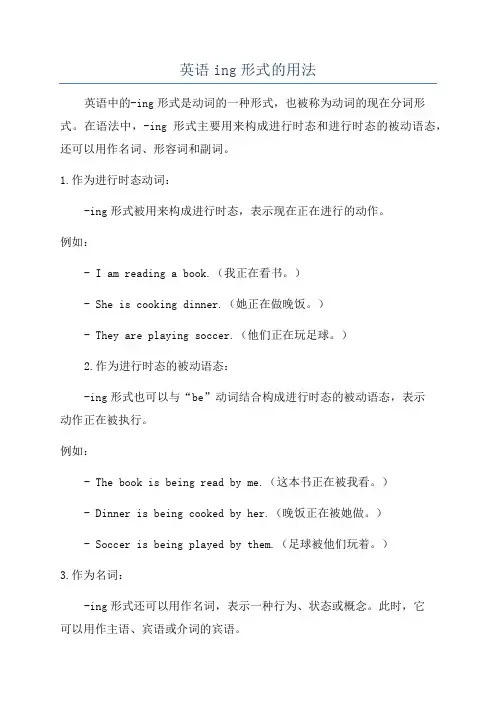
英语ing形式的用法英语中的-ing形式是动词的一种形式,也被称为动词的现在分词形式。
在语法中,-ing形式主要用来构成进行时态和进行时态的被动语态,还可以用作名词、形容词和副词。
1.作为进行时态动词:-ing形式被用来构成进行时态,表示现在正在进行的动作。
例如:- I am reading a book.(我正在看书。
)- She is cooking dinner.(她正在做晚饭。
)- They are playing soccer.(他们正在玩足球。
)2.作为进行时态的被动语态:-ing形式也可以与“be”动词结合构成进行时态的被动语态,表示动作正在被执行。
例如:- The book is being read by me.(这本书正在被我看。
)- Dinner is being cooked by her.(晚饭正在被她做。
)- Soccer is being played by them.(足球被他们玩着。
)3.作为名词:-ing形式还可以用作名词,表示一种行为、状态或概念。
此时,它可以用作主语、宾语或介词的宾语。
例如:- Swimming is good for your health.(游泳对健康有好处。
)- I enjoy cooking.(我喜欢烹饪。
)- She is tired of waiting.(她厌倦了等待。
)- He is interested in learning.(他对学习很感兴趣。
)4.作为形容词:-ing形式还可以用作形容词,用来描述人或物的特征或状态。
例如:- The running water is very refreshing.(流动的水非常令人清爽。
)- He is a charming man with a smiling face.(他是一个面带微笑的迷人男士。
)- The movie was boring.(电影很无聊。
)5.作为副词:-ing形式还可以用作副词,用来修饰动词、形容词或副词。
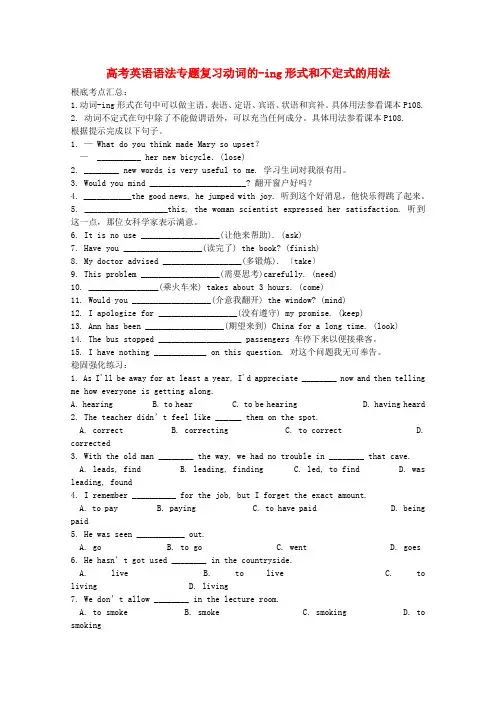
高考英语语法专题复习动词的-ing形式和不定式的用法根底考点汇总:1.动词-ing形式在句中可以做主语、表语、定语、宾语、状语和宾补。
具体用法参看课本P108.2. 动词不定式在句中除了不能做谓语外,可以充当任何成分。
具体用法参看课本P108.根据提示完成以下句子。
1. — What do you think made Mary so upset?— __________ her new bicycle.(lose)2. ________ new words is very useful to me. 学习生词对我很有用。
3. Would you mind ______________________? 翻开窗户好吗?4. ___________the good news, he jumped with joy. 听到这个好消息,他快乐得跳了起来。
5. ___________________this, the woman scientist expressed her satisfaction. 听到这一点,那位女科学家表示满意。
6. It is no use __________________(让他来帮助). (ask)7. Have you __________________(读完了) the book? (finish)8. My doctor advised __________________(多锻炼). 〔take〕9. This problem __________________(需要思考)carefully. (need)10. ________________(乘火车来) takes about 3 hours. (come)11. Would you __________________(介意我翻开) the window? (mind)12. I apologize for __________________(没有遵守) my promise. (keep)13. Ann has been __________________(期望来到) China for a long time. (look)14. The bus stopped ___________________ passengers 车停下来以便接乘客。
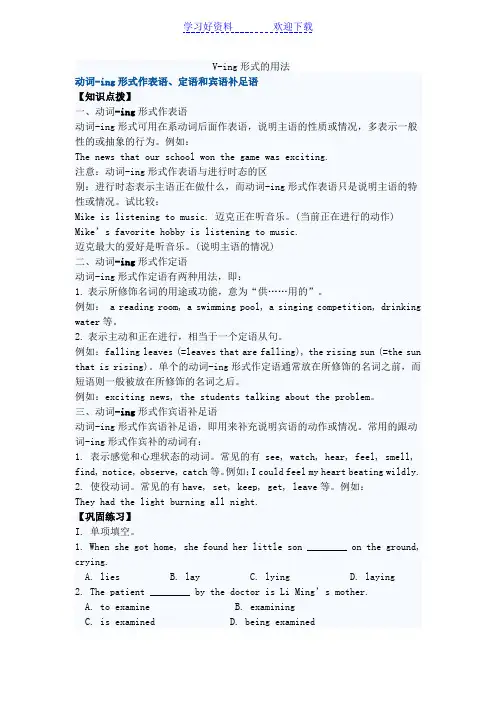
V-ing形式的用法动词-ing形式作表语、定语和宾语补足语【知识点拨】一、动词-ing形式作表语动词-ing形式可用在系动词后面作表语,说明主语的性质或情况,多表示一般性的或抽象的行为。
例如:The news that our school won the game was exciting.注意:动词-ing形式作表语与进行时态的区别:进行时态表示主语正在做什么,而动词-ing形式作表语只是说明主语的特性或情况。
试比较:Mike is listening to music. 迈克正在听音乐。
(当前正在进行的动作) Mike’s favorite hobby is listening to music.迈克最大的爱好是听音乐。
(说明主语的情况)二、动词-ing形式作定语动词-ing形式作定语有两种用法,即:1.表示所修饰名词的用途或功能,意为“供……用的”。
例如: a reading room, a swimming pool, a singing competition, drinking water等。
2.表示主动和正在进行,相当于一个定语从句。
例如:falling leaves (=leaves that are falling), the rising sun (=the sun that is rising)。
单个的动词-ing形式作定语通常放在所修饰的名词之前,而短语则一般被放在所修饰的名词之后。
例如:exciting news, the students talking about the problem。
三、动词-ing形式作宾语补足语动词-ing形式作宾语补足语,即用来补充说明宾语的动作或情况。
常用的跟动词-ing形式作宾补的动词有:1. 表示感觉和心理状态的动词。
常见的有 see, watch, hear, feel, smell, find, notice, observe, catch等。
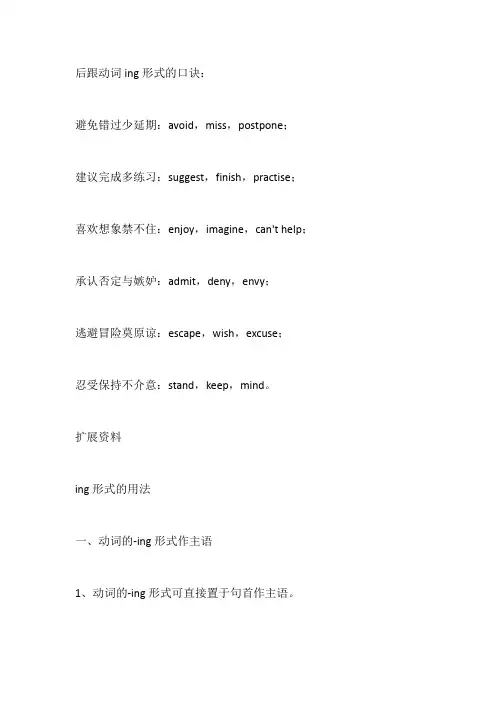
后跟动词ing形式的口诀:
避免错过少延期:avoid,miss,postpone;
建议完成多练习:suggest,finish,practise;喜欢想象禁不住:enjoy,imagine,can't help;承认否定与嫉妒:admit,deny,envy;
逃避冒险莫原谅:escape,wish,excuse;
忍受保持不介意:stand,keep,mind。
扩展资料
ing形式的用法
一、动词的-ing形式作主语
1、动词的-ing形式可直接置于句首作主语。
Seeing is believing.
百闻不如一见。
2、为了保持句子平衡,通常用先行词it作形式主语,而把真正的主语放在句末。
It is easy making plans, but it is difficult carrying them.
制定计划很容易,实行它却很难。
二、动词的-ing形式作表语
动词的-ing形式作表语的有两种不同的含义:
1、表示主语的内容是什么。
2、表示主语具有的特征。
三、动词的-ing形式作宾语
动词的-ing形式既可作及物动词的宾语,也可作介词的宾语。

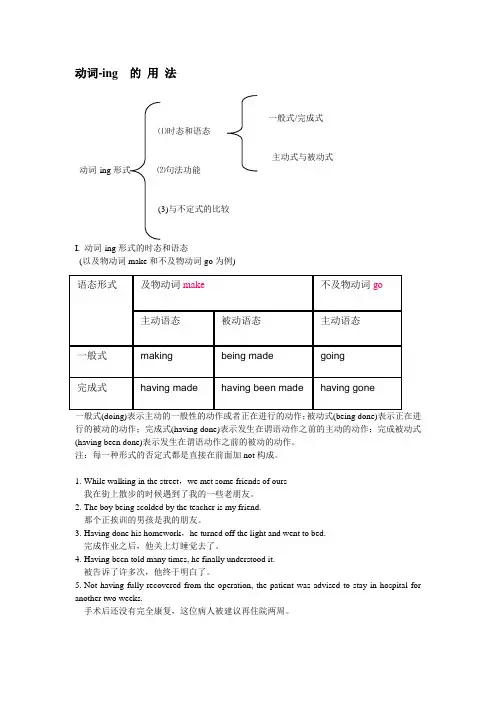
动词-ing 的用法一般式/完成式⑴时态和语态主动式与被动式动词-ing形式⑵句法功能(3)与不定式的比较I. 动词-ing形式的时态和语态(以及物动词make和不及物动词go为例)语态形式及物动词make不及物动词go主动语态被动语态主动语态一般式making being made going完成式having made having been made having gone一般式(doing)表示主动的一般性的动作或者正在进行的动作;被动式(being done)表示正在进行的被动的动作;完成式(having done)表示发生在谓语动作之前的主动的动作;完成被动式(having been done)表示发生在谓语动作之前的被动的动作。
注:每一种形式的否定式都是直接在前面加not构成。
1.While walking in the street,we met some friends of ours我在街上散步的时候遇到了我的一些老朋友。
2.The boy being scolded by the teacher is my friend.那个正挨训的男孩是我的朋友。
3.Having done his homework,he turned off the light and went to bed.完成作业之后,他关上灯睡觉去了。
4.Having been told many times, he finally understood it.被告诉了许多次,他终于明白了。
5.Not having fully recovered from the operation, the patient was advised to stay in hospital for another two weeks.手术后还没有完全康复,这位病人被建议再住院两周。
II. 动词-ing形式的句法功能1.动词-ing形式作主语(表示抽象动作)Lying is wrong. 撒谎是错误的。
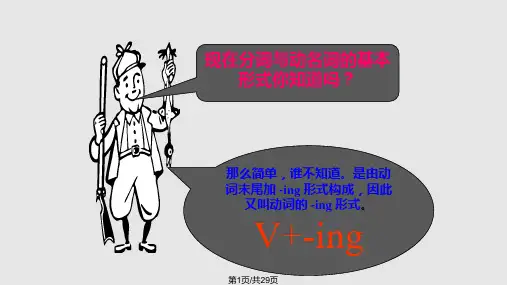
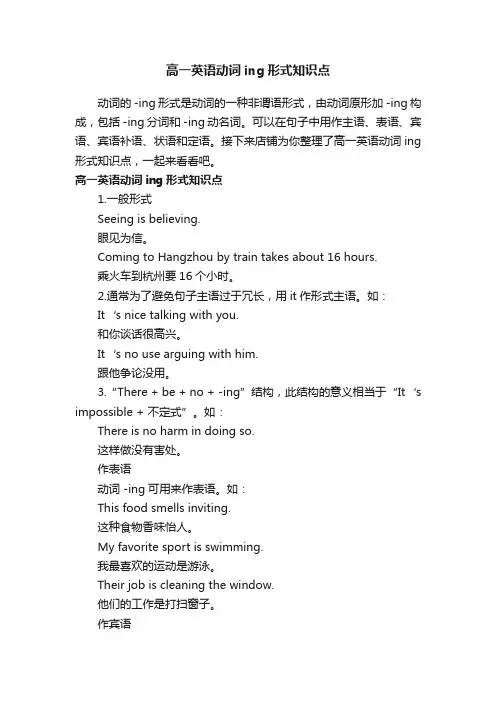
高一英语动词ing形式知识点动词的 -ing形式是动词的一种非谓语形式,由动词原形加 -ing构成,包括 -ing分词和 -ing动名词。
可以在句子中用作主语、表语、宾语、宾语补语、状语和定语。
接下来店铺为你整理了高一英语动词ing 形式知识点,一起来看看吧。
高一英语动词ing形式知识点1.一般形式Seeing is believing.眼见为信。
Coming to Hangzhou by train takes about 16 hours.乘火车到杭州要16个小时。
2.通常为了避免句子主语过于冗长,用it作形式主语。
如:It‘s nice talking with you.和你谈话很高兴。
It‘s no use arguing with him.跟他争论没用。
3.“There + be + no + -ing”结构,此结构的意义相当于“It‘s impossible + 不定式”。
如:There is no harm in doing so.这样做没有害处。
作表语动词 -ing可用来作表语。
如:This food smells inviting.这种食物香味怡人。
My favorite sport is swimming.我最喜欢的运动是游泳。
Their job is cleaning the window.他们的工作是打扫窗子。
作宾语1.动词-ing形式可以用作动词、短语动词和介词的宾语。
I warned her against driving fast.Jim dislikes eating chocolate.2.有些动词和动词短语后接作宾语的非限定性动词时只能是-ing 分词,常见的这类动词有:admit,acknowledge,advise,appreciate, avoid, delay, deny, dislike, enjoy, excuse,escape,fancy, finish, forgive, face, endure, involve, give up,imagine, mention, mind, miss, pardon,practise, require, resent, resist, suggest, recall, resist,understand等。
动词-ing变化规则一、动词V-ing形式的用法1.用于进行时中,叫做现在分词。
基本句型:be+V-ing(注意be的变形)。
译为“正在...”01.现在进行式:(am,is,are)+V-ing02.过去进行式:(was,were)+V-ing03.将来进行式:(will be)+V-ing04.过去将来进行式:(would be)+V-ing05.现在完成进行式:(have been,has been)+V-ing06.过去完成进行式:(had been)+V-ing在某些特定动词和介词后边,用V-ing形式,这时V-ing叫做动名词,汉语意思不变。
这样的动词以后会单独专学。
3.某些动词变为V-ing形式后,起到形容词作用。
译为:“正在...的...”“令人感到...的”这部分会在V-ing变形结束后,近期会单列学习。
如:move(感动)---moving令人感动的,动人的Interest(使...感兴趣)---interesting 令人感兴趣的;有趣的二、动词ing形式的用法及变化规则:在动词词尾加-ing构成,其规则如下:1)一般情况下,在动词词尾直接加-ing,如:01.check(检查;核对)—checking 05.help(帮助)—helping02.call(叫;打电话给)—calling 06.look(看...)—looking03.rain(下雨)—raining 07.listen(听...;倾听)—listening04.answer(回答)—answering 08.talk(谈论;说话)—talking2)以一个字母-e结尾的单词,去掉字母-e,再加-ing,但是双写-ee结尾的,要直接加-ing。
如:01.move(移动;感动)—moving 05.hope(希望)—hoping02.like(喜欢;愿意)—liking 06.agree(同意)—agreeing03.close(关闭;结束)—closing 07.see(看见)—seeing04.waste(浪费;消耗)—wasting 08.free(释放)—freeing3)以重读闭音节结尾,即“辅+元+辅”结尾的动词,先双写末尾的辅音字母,再加-ing。
动词-ing形式的用法
动词-ing形式是英语中一种非限定性动词形式,通常在句子中作为动词或形容词的补充使用。
下面是动词-ing形式的几种常见用法:
1. 动作的进行
动词-ing形式可以表示动作的进行。
例如:
- I am studying for my exam. (我正在为考试复。
)
- They are playing basketball in the park. (他们在公园里打篮球。
)
2. 表示惯或常态
动词-ing形式还可以表示惯或常态的动作。
例如:
- I enjoy reading books. (我喜欢读书。
)
- She loves dancing. (她喜欢跳舞。
)
3. 作形容词补足语
动词-ing形式也可以作为形容词的补足语,修饰名词。
例如:- The running water is very clean. (流动的水非常干净。
)
- I saw a dancing girl at the party. (我在派对上看到了一个跳舞
的女孩。
)
4. 作状语
动词-ing形式还可以作为状语,对句子的动作进行修饰。
例如:- She left the room, crying. (她边哭边离开了房间。
)
- He typed the document, smiling. (他一边微笑着,一边打字。
)
需要注意的是,动词-ing形式的用法并不是固定的,具体还要
根据句子的语境来确定。
以上是动词-ing形式的一些常见用法,希望对您有帮助。
-i n g分词的用法一、-ing分词的构成-ing分词是由动词原形加词尾-ing构成;-ing分词同样有时态和语态的变化,通常有下表几种形式以do为例:一般式完成式主动形式 doing 主动形式 having done被动形式 being done 被动形式 having been done-ing分词的否定形式是由not 加-ing分词构成;如:Not knowing his address, I could do nothing but stay at home and wait.不知道他的地址,我只好在家里等着;His not coming made all of us angry. 他没来使我们大家都很生气;1.-ing分词的一般式 doing1). 动词V-ing形式的一般式可用来泛指一个动作,没有特别的时间意义;Eg:Learning is important to modern life.学习对现代生活很重要;Eg:Swimming is her favorite sport.游泳是她最喜欢的体育运动;2.-ing分词的一般式表示和谓语动词所表示的动作同时进行的动作;Eg:Being a student, he was interested in books. 作为一个学生,他对书本很感兴趣;Eg:They went out of the classroom, talking and laughing. 他们有说有笑地走出教室;2.-ing分词完成式 having done:完成式表示动作在谓语动词所表示的动作之前发生的动作;Eg:Not having studied his lessons very hard, he failed the examinations. 因为没有努力学习功课,他考试不及格;Eg:Having answered the letter, she went on to read an English novel.Eg:Having lived in this city for three years, she knows it very well.3. -ing分词的被动式 being done :-ing分词的被动式表示它的逻辑主语是-ing分词动作的承受者;被动语态-ing一般式所表示的动作是一个正在进行中的被动动作. Eg:The question being discussed is very important. 正在被讨论的问题很重要;4. having done的被动形式having been done表示它的逻辑主语是动词-ing形式表示的动作的承受者;表示动作在谓语表示的动作之前发生;Eg:Having been criticized by the teacher, he gave up smoking. 被老师批评以后,他把烟戒了;Eg:Having been shown the lab, we were taken to see the schoollibrary.在被带去看了实验室之后,我们又被带去参观校图书馆;5动词-ing形式的否定形式;动词-ing形式的否定形式通常是在其前加not,带有逻辑主语时not 应放在动词-ing形式之前;Eg:Excuse me for my not coming on time.Eg:I’m sorry for not having kept my promise.例1. ______ to the station on time made everyone wor ried last week.A. Him not gettingB. Not his gettingC. His not gettingD. Not getting6.动词-ing形式的复合结构动词ing形式的复合结构由形容词性物主代词或人称代词宾格,名词所有格或普通格加动名词,动名词的复合结构实际上是给动名词加了一个逻辑主语; 动词-ing形式的复合结构有四种形式:①形容词性物主代词+动名词②名词‘s +动名词③代词宾格+动名词④名词+动名词注意动名词的复合结构可在句中作主语或宾语;作主语时,不能用③④两种形式;Eg:Tom’s winning the first prize last year impressed me a lot. 汤姆去年得了一等奖使我印象深刻;Eg:Do you mind my/me/Jack’s/Jack leaving now.翻译练习:His coming made us very happy. 他的到来使我们大家都很高;翻译练习:He was awakened by someone’s knocking at the door. 他被某人的敲门声吵醒了;二 -ing分词的语法作用动词-ing一方面具有动词的性质,另一方面也相当于一个名词或形容词、副词,在句中可以作主语、表语、宾语、定语、状语和补语等; 1–ing分词短语作主语: 动词ing形式作主语往往表示经常性、习惯性的动作,谓语动词用单数:Eg:Reading books widens our knowledge.读书增长我们的知识Eg:Saying is easier than doing. 说比做容易;翻译练习:Learning English well is not easy.在下面两种结构中,-ing分词也作主语;A.It is no use/no good/useless/worthwhile/dangerous/a wa ste of time /fun等后需用动名词作真正的主语;为了保持句子平衡,通常用it 作形式主语,而把真实主语放在句末;Eg:It is no use crying over spilt milk. 覆水难收Eg:It's a waste of time arguing about it. 辩论这事是浪费时间;翻译练习:It is no use waiting for him any longer.B.当句型“There is no doing…”表示“不允许、禁止某种行为的发生或存在”时,需用动名词作主语;Eg:There is no joking about such matters. 这种事开不得玩笑;There is no point indoing sth 干…….没意义; Eg:There’s no point in waiting. 等待是毫无意义的; There is no senseindoing sth. 干…没道理/意义例.1.In my mind,_____ that famous university will be the only way to become a worlds-class writer. A. attending B.to attend C. attendD. having attended2. My grandfather is a millionaire, but _____ money does not solve all his problem.A. hasB. to haveC. havingD. having had2 -ing分词短语作表语:Eg:His hobby is collecting stamps. 他的爱好是收集邮票; Eg:The problem is quite puzzling. 这个问题很令人困惑;3 -ing分词作宾语:①–ing分词可作动词宾语, 作动词的宾语;mind介意, suggest建议, enjoy欣赏,, admit承认, appreciate 感激,欣赏, avoid避免, delay推迟, dislike不喜欢,厌恶, escape 逃脱, finish完成, forgive宽恕, imagine想象, keep保持, miss 错过, practise训练, resist抵抗,抵制, risk冒险, deny拒绝,否认, consider考虑等;Eg:I suggest doing it in a different way. 我建议用另一种方法做这件事;Eg:We enjoy attending Miss Li''s class. 我们喜欢听李老师的课;例1:He got well-prepared for the job interview, for he couldn’t risk _____ the good opportunity.A. to loseB. losingC. to be lostD. being lost答案B.后risk 后接动名词,he与 lose是主谓关系;2:Bill suggested _____ a meeting on what to do for the Shanghai Expo during the vacation.A. having heldB. to holdC. holdingD. hold3.To improve your spoken English, you should practic e_____ it every day. A. speak B. to be spo ken C. speaking D. to speak②-ing分词作宾补,也可用在复合宾语中作真正的宾语,而用it作形式宾语;如:Eg:I don’t think it possible living in such a cold place. 我认为住在这么寒冷的地方是不可能的;Eg:Do you consider it any good trying again 你觉得再试一次会有好处吗③-ing分词作介词宾语,经常用在一些短语的后面;如:Eg:I'm against inviting him to dinner. 我反对邀请他来吃饭; Eg:They don’t feel like walking that much. 他们不喜欢走那么多路;翻译练习:Don’t be afraid of speaking English.不要害怕说英语;此类短语还有很多;如:can’t help忍不住be proud of以……自豪, be responsible for对……负责, insist on坚持, keep on 继续think of考虑,想到, dream of梦想, hear of听说, prevent…from防止,阻止, keep…from防止,阻止, stop…from防止,阻止, be engaged in从事于, depend on依靠,依赖, thank…for因……而道谢, excuse…for因……而道歉, aim at目的在于, set about着手做, be fond of喜欢, be afraid of害怕, be tired of对……厌烦, succeed in成功地做……, be interested in对……感兴趣, be ashamed of对……感到羞愧, put off推迟, give up放弃, be worth值得做……, be busy in doing sth 忙于做某事 ,等等;注意:在有些句子中,介词常可省去;如:Eg:I have no difficulty in communicating with foreigners. 我在和外国人交谈方面没有什么困难;Eg:What can prevent us from getting married 有什么能阻止我们结婚翻译练习: Farmers were busy in getting in the crops. 农民在忙着收庄稼;翻译练习: I have never dreamed of visiting that place. 我从未梦想过要参观那个地方翻译练习: He used to spend a lot of time in playing games. 过去他常花很多时间玩游戏;例1.The girl said that she had never dream of _____a volunteer.A. beB. to beC. beingD. is2. I had great difficulty _____ the suitable food on the menu in that restaurant.A. findB. foundC. to findD. finding3. Seeing the funny scene, I can’t help______.A. laughB. to laughC. laughingD. laughed另外,-ing分词可以和一些介词如in, on, after, against, before, by, for, without, besides等构成短语,在句中作状语;如:Eg:He left ahead of time without saying a word. 他一句话也没说就提前离开了;Eg:Besides cooking and sewing, she had to take care of four children.除了做饭和缝纫以外,她还要照顾四个孩子;Eg:On hearing the news, all the pupils jumped with joy. 一听到这个消息后,所有的学生都高兴得跳了起来;4 -ing分词作定语:①单个的分词作定语一般放在被修饰词的前面,–ing分词作定语可用来说明被修饰的名词的用途和性能;如:reading material 阅读材料 walking stick 手杖 fishing pole 鱼杆flying suit 飞行服 writing table 写字台 listening practice 听力训练reading room 阅览室 swimming pool 游泳池 dining car 餐车sleeping car 卧车 singing competition 歌咏比赛 waiting room 候车室②-ing分词作定语还可以表示所修饰的人或物的动作或状态,在意思上接近一个定语从句,可以表示正在进行的动作,也可表示经常性动作或当时的状态;如:developing countries = countries that are developing 发展中国家a growing city = a city that is growing 发展着的城市Eg:Who is the student standing by the door 站在门边的同学是谁Eg:They lived in a house facing south.=They lived in a house which faces south. 他们住在一所朝南的房子里;翻译练习:坐在我旁边的女孩是我妹妹;The girl sitting beside me is my sister.翻译练习:有人在敲门There is someone knocking at the door.③–ing分词还可以作非限制性定语,相当于一个非限制性定语从句,常用逗号和句子其它部分分开;如:Eg:When she appeared, John, wearing a dirty and worn-out overcoat, ran to her with joy. 当她出现的时候,约翰穿着一件又脏又破的大衣高兴地跑了过去;5 -ing分词做状语:动词-ing形式作状语可以修饰谓语动词或整个句子,可以表示时间、原因、结果、条件、让步、方式或伴随情况等;①.表示时间:-ing分词短语作时间状语,相当于一个时间状语从句,有时可由连词when, while引出;Eg:Turning around, she saw a car driving up.=When she turned around, she saw a car driving up. 她转过身,看见一辆车朝她开来;Eg:While reading the book, he nodded from time to time. 他一边看书,一边不时地点头;翻译练习:看到那些画,他想起了她的童年;Seeing those pictures, she remembered her childhood.翻译练习: 听到这消息时我们高兴地跳了起来;Hearing the news, we jumped with joy.②表示原因:-ing分词短语作原因状语,相当于一个原因状语从句;Eg:Being tired, he could not walk any further.=As he wastired, he could not walk any further. 因为疲倦,他不能再往前走了;Eg:Not knowing his address, I can’t send this book to him. 因为不知道他的地址,我不能把这本书送给他;Eg:Many of us, being so excited, couldn’t go to sleep that night. 因为非常激动,那晚我们许多人都没睡着;翻译练习:因为不知道路,他无法到那里去;Not knowing the way, he could’t go there.翻译练习:因为激动他睡不着;Being excited , she couldn’t go to sleep.③表示结果:–ing分词短语作结果状语;表示一种必然的结果,可扩展为一个含有并列谓语的简单句;The fire lasted nearly a month, leaving nothing v aluable.=The fire lasted nearly a month, and left nothing valuable. 大火持续了近一个月,几乎没剩下什么值钱的东西; Eg:His father died, leaving him a lot of money. 他父亲死了,留给他许多钱;Eg:She was so angry that she threw the toy on the ground, breaking it into pieces.她非常生气,把玩具扔在地上,把它摔成了碎片;④表示伴随.-ing分词作伴随状语,可以放在句子的前面、后面或中间,表示主语的另一个、较次要的动作;如:Eg:I stood by the door, not daring to say a word.=I stood by the door, and did not dare to say a word. 我站在门旁,不敢说一句话;Eg:They stood there for half an hour,watching the stars in the sky. 他们在那儿站了半小时,观察着天上的星星;翻译练习:年轻人跟在老人的后面开始慢慢地走起来;Following the old man, the young people started walking slowly. 翻译练习:他们在那儿站了一个小时观看比赛;They stood there for an hour watching the game.⑤表示条件:动词-ing形式作条件状语,相当于一个条件状语从句;Being more careful, you can make fewer mistakes.=If you are more careful, you can make fewer mis takes. 更细心点,你就会少犯错误;Turning to the left, you ‘ll see the tower.向左转,你就会看到那座塔;翻译练习:如果努力,你就会成功;Working hard, you will succeed.⑥“with/without+名词普通格或代词宾格+-ing分词”结构在句中作状语,表示伴随情况或时间、原因等;如:Eg:His hair became gray with the years passing. 随着时间的推移,他的头发变花白了;Eg:Without anyone noticing, he slipped through the window. 没人注意,他从窗户溜了出去;例1.The storm left, ______ a lot of damage to this area.A. causedB. to have causedC. to causedD. having caused例2.----“You can’t catch me” Janet shouted, ______ away.A. runB. runningC. to runD. ran 例3.It’s necessary to be prepared for a job interview. ______ the answers ready will be of great help.A. To have hadB. Having hadC. HaveD. Having 例 4._____ from other continents for millions of years, Australia has many plants and animals not found in any other country in the world.A. Being separatedB. Having separatedC. Having been separatedD. To be separated例5.Daddy didn’t mind what we were doing, as long as we were together, _____ fun.A. hadB. haveC. to haveD. having 例6.Oil prices have risen by 32 percent since the start of the year, _____ a record $57.65 a barrel on April 4.A. have reachedB. reachingC. to reachD. to be reaching例7.It was unbelievable that the fans waited outside the gym for three hours just _____ a look at the sports stars.A. hadB. havingC. to haveD. have例8._____ more about university course, call 9207463789. A. To find out B. Finding out C. Find out D. Having found out简析:1.D.结果状语,时间有明显先后之分;2.B.伴随状语;3.D.条件状语,有明显时间先后之分;4.C.原因状语,时间有明显先后之分;5.D.伴随状语;6.B.结果状语;7.C.作目的状语;8.A.作目的状语;6 -ing分词作补语:--ing分词可以在see, hear, notice, watch, feel, look at, listen to, observe, have, get, leave, keep, set, catch, find等动词后面和一个名词或代词构成一个复合宾语,作宾语补语;如:Eg:I noticed a man running out of the bank when I got off the car.我下车的时候注意到一个男人匆匆忙忙地从银行里跑出来;Eg:Last night the shopkeeper caught a child stealing some food in the shop.昨晚,店主在商店里抓到一个小孩在偷东西;翻译练习:I saw him going upstairs.我看见他正在上楼;翻译练习:We watched her crossing the street. 我们看着她穿过大街;三. –ing分词作主语和表语时与不定式的区别:1、-ing分词和动词不定式作主语和表语的主要区别在于:在表示比较抽象的一般的多次性行为时多用-ing分词;在表示具体的或一次性的动作,特别是将来的动作时,多用不定式;如:Eg:Smoking is forbidden here. 泛指吸烟这里禁止吸烟;Eg:It’s not good for you to smoke so much. 指你吸烟吸这么多烟对你的身体不好;2、有些动词既能接不定式,又能接-ing分词,含义有所不同;如:Remember doing sth 记得做了某事Remember to do sth 记住要去做某事Forget doing sth 忘记做了某事Forget to do sth 忘记要去做某事Regret doing sth 后悔做了某事Regret to do sth 遗憾要去做某事Mean to do sth 打算做某事Mean doing sth意味着做某事Stop to do sth 停下来去做某事Stop doing sth 停止做某事Try to do sth 努力/企图做某事Try doing sth 试着做某事Eg:Do you remember seeing me before 你记得以前见过我吗Eg:Remember to lock the door when you leave. 离开时要记得锁门;Eg:I try not to think about that. 我尽量不去想那件事;Eg:Would you please try doing that again 请你再试一次好吗Eg:I mean to change it for another one. 我想换成另外一个; 翻译练习:Having finished the exercises, we went on to learn the new words in the next unit.做完练习以后,我们继续学习下一单元的单词;翻译练习:After a short rest, they went on working. 短暂地休息以后,他们又继续工作;翻译练习:Missing the train means waiting for another hour. 错过这班车就意味着再等一个小时;例 1. Never mind. Please try _____ the problem in another way.A. solveB. to solveC. being solvedD. solving例2. When asked by the police, he said that he remembered _____ at the party, but not _______.A. to arrive, leavingB. to arrive, to leaveC. arriving, leavingD. arriving, to leave答案 C.记得来过晚会,用arriving,但是后的动作仍然记得,用leaving.3、动词allow, advise, forbid, permit等可直接跟-ing分词作宾语,不可以接动词不定式作宾语,但可接不定式作宾语补语;如:Eg:We don’t permit smoking here. 我们这儿不允许吸烟;Eg:Please permit me to say a few words. 请允许我说几句话; 例1.---Can I smoke here----Sorry. We don’t allow_____ here.A. people smokingB. people smokeC. to s mokeD. smoking4、动词need, require, want作“需要”解时以及deserve作“值得”解时,后面接-ing分词或不定式的被动式;need / want/require/deserve doing=need/want/require/dese rve to be done Eg:The lake needs repairing/ to be repairedEg:These little children require looking after carefully/to be looked after carefully. 这些小孩需要细心地照料;翻译练习:Your shoes need cleaning/ to be cleaned. 你的鞋需要清洗一下了;翻译练习:The room wants cleaning/to be cleaned. 这个房间需要打扫;例:As a result of the serious flood, two-third of the buildings in the area______.A. need repairingB. needs to repairC. needs repairingD. need to repair5、动词like, hate, prefer等后面,如表示一般性动作,多用-ing 分词;如指特定的具体的某次动作,多用不定式;如:Eg:I like swimming, but I don’t like to swim with you. 我喜欢游泳,但我不喜欢和你一起游泳;Eg:I prefer walking to school every day. 我情愿每天步行去学校;Eg:I prefer to stay at home today. 今天我情愿呆在家里;6、-ing分词作表语的两种不同含义:①-ing分词作表语可以表示主语的内容是什么;Eg:Their job is building houses. 他们的工作是盖房子;Eg:The real question is getting to know the needs of the people. 真正的问题是了解人民的需要;②-ing分词作表语还可以表示主语所具有的特征;如:Eg:This story is very interesting. 这故事很有趣;Eg:The problem is quite puzzling. 这个问题很令人困惑;7、不定式和-ing分词作宾语补语的区别:在see, hear, feel, watch, notice等感官动词后,既可用-ing分词构成复合宾语,也可用不定式构成复合宾语,两者之间有一定的区别;用-ing分词时,表示动作正在进行;用不定式时,表示动作发生了,即动作的全过程结束了;如:Eg:Do you hear someone knocking at the door Someone isknocking at the door. 有人在敲门你听见了吗Eg:Do you hear someone knock at the door Someone knocked at the door just now. 你听见有人敲门了吗8、高中阶段常见的带介词to的短语,后接-ing分词或名词;如:look forward to渴望,盼望admit to承认, contribute to捐助、贡献, get down to着手做, give way to让位于,keep to 坚持、遵守, lead to 导致, take to从事, turn to 求助于, stick to忠于、坚持, point to指向、表明, see to 注意、处理, be used to 习惯于, devote oneself to 献身于, be equal to 胜任的、等于, be familiar to 为……熟悉be/get used to习惯于 object to反对,抗议pay attention to注意 .9、高中阶段有一些固定的-ing分词短语,如:generally speaking 一般来说, judging from…根据……来判断, considering…考虑到……, talking of…谈到……,提到……, supposing…假如……等,它们的逻辑主语和句子的主语不一致;这种短语可以被称之为句子的状语,也可当作一个插入语;如:Eg:Judging from his accent, he must come from Canada. 从他的口音看他一定来自加拿大;Eg:Considering how poor he was, we decided to let him attend the concert for free.考虑到他是多么的穷,我们决定让他免费听音乐会;Exercises:1. The officers narrowly escaped ___________in the hot battle.A. have killedB. to killC. to be killedD. being killed2.___________ the letter, he went out to post it.A. WritingB. Being writingC. Having writtenD. Written3. Don't you remember ___________A. seeing the man beforeB. to see the man beforeC. saw the man beforeD. to have seen the man before4. People couldn't help ___________ the foolish emperor in the procession.A. laugh atB. to laugh atC. laughing atD. laughing on5. We're looking forward ___________ the photo exhibition.A. to visitingB. to visitC. to having visitedD. visiting6. The girl ___________ under that tree is my sister.A. sittingB. sitsC. is sittingD. sat7. This sentence needs ___________ .A. a improvementB. improveC. improvingD. improved8. ___________ anything about the accident, he went to work as usual..A. Not knownB. Known notC. Knowing notD. Not knowing9. The next morning she found the man ___________ in bed, dead.A. lyingB. lieC. layD. laying10. There was terrible noise ___________ the sudden burst oflight.A. followedB. followingC. to be followedD. being followed11. The secretary worked late into the night, ___________ a long speech for the president.A. to prepareB. preparingC. preparedD. was preparing12. "Can't you read " Mary said ___________ to the notice.A. angrily pointingB. and point angrilyC. angrily pointedD. and angrily pointing13. How about two of us ___________ a walk down the gardenA. to takeB. takeC. takingD. to be taking14. ---I must apologize for ___________ahead of time. ---That's all right.A. letting you not knowB. not letting you knowC. letting you know notD. letting not you know15. ---You were brave enough to raise objections at the meeting. ---Well, now I regret ___________ that.A. to doB. to be doingC. to have doneD. having done16. Would you ___________ me your identification card, sirA. mind to showB. mind showingC. trouble to showD. trouble showing17. He suggested ___________ on Saturday.A. to have a meetingB. having a meetingC. a meeting to haveD. that having a meeting18. It is no good ___________ to come now. He is busy.A. if you ask himB. to ask himC. asking himD. that you ask him19. Although punctual himself, the professor was quite used ___________ late for his lecture.A. to have studentsB. for students to beC. for students' beingD. to students' being20. He dressed himself quickly and ___________ his schoolbag, went to school.A. carriedB. to carryC. carryingD. carries21. ___________ for several weeks, the city needed food.A. As having floodedB. being floodedC. Having been floodedD. To flood22. ___________ ill worried my parents greatly.A. I fellB. Me fallingC. My fallingD. I falling23. She is writing a letter to a friend of hers, ___________ him to attend the meeting.A. having invitedB. invitingC. to inviteD. invited24. Our town has dozens of factories, ___________several saw mills.A. includedB. are includingC. are includedD. including25. ___________ the classroom, the students went to theplayground to watch the football match.A. To cleanB. Having cleanedC. CleanedD. Cleaning语法专项练习二1.北京 ________in the queue for half an hour, Tom suddenlyrealized that he had left his wallet at home.A. To waitB. Have waitedC. Having waitedD. To have waited2.上海 According to a recent U.S. survey, children spent up to25 hours a week ______TV.A. to watchB. to watchC. watchingD. watch3.上海 The flu is believed _______ be viruses that like toreproduce in the cells inside the human nose and throat.A. causingB. being causedC. to be causedD. to have caused4.上海 The flowers ______ sweet in the botanic garden attractthe visitors to the beauty of nature.A. to smellB. smellingC. smeltD. to be smelt5.天津 Don’t leave the water ______ while you brush your teeth.A. runB. runningC.being run D. to run6.重庆 They see you as something of a worrier, ______ problemswhich don’t exist and crossing bridges long before you cometo them.A. settlingB. discoveringC.seeing D. designing7.福建The news reporters hurried to the airport, only ______the film stars had left.A. to tellB. to be toldC.telling D. told8.湖南 You were silly not _____ your car.A. to lockB. to have lockedC. lockingD. having locked9.江苏 The man insisted _______ a taxi for me even though I toldhim I lived nearby.A. findB. to findC. onfinding D. in finding10.江苏 The old man, _______ abroad for twenty years, is on theway back to his motherland.A. to workB. workingC. to haveworked D. having worked1-5 D C A C D6---10 A C D A B 11---15 B A C B D 16---20 B B C D C 21---25 C C B D B 1—10 CCCBB CBBCD。
现在进行时除表进行外,还可以表示将来。
现在进行时表将来时常用“意图”“安排”或“打算”的含义。
这种现在进行时比较生动,给人一种期待感。
它常表最近或较近的将来,所用动词多是转移动词。
如:(1) I’m going. 我要走了。
(2) I'm coming.我要来了。
(3) When are you starting? 你什么时候动身?表将来的现在进行时除用于转移动词外,亦可用于某些非转移动词。
如:(1) I’m meeting you after class. 课后我找你。
(2) What are you doing next Sunday? 下星期你打算干什么?(3) She is buying a new bike soon. 她不久将买一辆新自行车。
但偶尔也表示较远的将来。
如:When I grow up, I’m joining the army. 我长大了要参军。
表将来的现在进行时有时含有“决心”的意思,多用在否定结构中。
如:(1) I’m not going. 我不走了。
(2) I’m not w aiting any longer. 我不再等了。
有时也用在肯定结构中。
如:I’m backing out. 我要打退堂鼓了。
用这种现在进行时与对方讲话时可变成命令,不过语气比较温和。
如:(1) You are staying. 你留下吧。
(2) Don’t forget: you are taking part too. 不要忘记:你也要参加。
同一般现在时一样,现在进行时也可在时间、条件或原因状语从句中表示将来。
如:(1) when you are passing my way, please drop in. 你什么时候路过我们家,请进来坐。
(用于时间状语从句)(2) If they are not doing it, what am I to do? 如果他们不干,那我该怎么办?(用于条件状语从句)(3) She is going to the dentist tomorrow because she is havinga tooth filled.表示将来的现在进行时也可用在间接引语中,表示说话人相信它将是事实。
V-ing形式的用法动词-ing形式作表语、定语和宾语补足语【知识点拨】一、动词-ing形式作表语动词-ing形式可用在系动词后面作表语,说明主语的性质或情况,多表示一般性的或抽象的行为。
例如:The news that our school won the game was exciting.注意:动词-ing形式作表语与进行时态的区别:进行时态表示主语正在做什么,而动词-ing形式作表语只是说明主语的特性或情况。
试比较:Mike is listening to music. 迈克正在听音乐。
(当前正在进行的动作) Mike’s favorite hobby is listening to music.迈克最大的爱好是听音乐。
(说明主语的情况)二、动词-ing形式作定语动词-ing形式作定语有两种用法,即:1.表示所修饰名词的用途或功能,意为“供……用的”。
例如: a reading room, a swimming pool, a singing competition, drinking water等。
2.表示主动和正在进行,相当于一个定语从句。
例如:falling leaves (=leaves that are falling), the rising sun (=the sun that is rising)。
单个的动词-ing形式作定语通常放在所修饰的名词之前,而短语则一般被放在所修饰的名词之后。
例如:exciting news, the students talking about the problem。
三、动词-ing形式作宾语补足语动词-ing形式作宾语补足语,即用来补充说明宾语的动作或情况。
常用的跟动词-ing形式作宾补的动词有:1. 表示感觉和心理状态的动词。
常见的有 see, watch, hear, feel, smell, find, notice, observe, catch等。